|
[ Back ] [ Home ] [ Up ] [ Next ]
Photo
Gallery of our Angel Falls trip
* * Click pictures to enlarge;
close out of that window to return to
this page * *
|
PASSAGE from TRINIDAD
to VENEZUELA
|
|
DECEMBER 8 - 12, 2004:
. . . We left
Chaguaramas, Trinidad and made a
big 3-mile trip over to lovely
Scotland Bay on the west coast
to stage for our overnight passage.
Here in Scotland we spent 2 days
listening to the loud "roar" of the
Howler Monkeys and waiting for the
rain to pass, and to decompress from
the busy social life and seemingly
never-ending boat projects in
Chaguaramas. Actually got out
the 2 books we started to read over
3 months ago and started up on them
again. The peace and quiet was
so nice for a change.
We
left Scotland Bay at 8:00 a.m. and
arrived safely in Porlamar, Isla
de Margarita, Venezuela at
sunrise the next day. We
picked the right weather window as
seas tapered off to 1-foot swells
from behind so rolling wasn't too
bad, but winds astern were
light so had to motor sail. We
were doing 8.5 knots at times (1 -
1.5 knot current with us), then
slowed down so we wouldn't get to
Margarita in the dark.
Traveling off the northeastern coast
of Venezuela is considered dangerous
due to piracy, so cruisers typically
travel many miles offshore and
without lights at night. Upon
leaving Trinidad, we went due North
16 miles (10 deg 56' thereabouts)
then turned due west for 122 miles
to Margarita. Even though we
originally said we would run with
lights due to reportedly heavy
shipping and fishing traffic, we
ended up running without lights as
there was not much traffic. We
only lit up when we saw fishermen
and when we were about 15 nm out of
Porlamar. It was also a clear,
starry (moonless) night which made
it easier to see.
ARGO is equipped with radar, a big
radar reflector (we've been told we
look like a big ship on radar) and
the C.A.R.D. system. We also
had the Q-beam (a very bright spot
light), flare guns and pepper spray
handy just in case we had unwanted
visitors during the night, and a
plan: go below and lock
ourselves in to keep intruders from
getting below. As it goes, if
you're prepared for something, then
probably won't need to use it, and
so it was an uneventful passage.

Several dozen dolphins kept us
company for several hours until
morning twilight broke.
|
|
VENEZUELA
|
|

Porlamar, Margarita:
city and anchorage

Don's boat, friend
to all pelicans (and smells like a
zoo)

Isla Coche:
kite-boarders


North coast of
Venezuela |
VENEZUELA,
DECEMBER 12, 2004 -
: We arrived in
Porlamar, Margarita, an island
off the north coast of Venezuela.
We were here in
fall 2003 for 6 weeks, so have
seen and done this island already.
But the attraction to Margarita is
that it is duty free, in fact,
Venezolanos come here from the
mainland to stock up. Our
priorities are set: Buy beer
(US$3.50/case), wine ($3.50/bottle),
rum ($2/bottle) and other liquor,
excellent quality "lomitos" filet
mignon ($3.80/lb.), diesel
($0.28/gal.), quality reading
glasses (hate getting older eyes)
and miscellaneous consumer goods.
We are ready to leave 6 days later
after catching up with various
friends here.
A day sail takes us
to Isla Coche, once home to
thriving pearl beds in the 1500's.
It is an odd little island, with
bare red cliffs at one end, some
kind of mining in the middle and a
"resort" at the other end -
supposedly Europeans like to holiday
here, not sure why, although there
were enough kite-boarders here to
make it look popular.
A 5:00 a.m.
departure in the dark gave us a day
sail (motor) to Puerto La Cruz on
the north coast of mainland
Venezuela. A group of dolphins
greeted us with sunrise, only to
return 6 hours later (one was
recognizable with a 3-inch scar on
it's left "shoulder").
Although not enough wind to sail,
the day was beautiful with gorgeous
skies, as we went past many islands
and along the coast. It was
like sailing through Colorado and
New Mexico: High mountains,
some with bare red-rock cliffs,
others plentiful with green trees.
Truly breathtaking.
We arrive at the
Bahia Redonda Marina in Puerto La
Cruz (near Barcelona) greeted by our good friends
from Houston, Bob & Susan, s/v
Sunrise. They have been
here for a year now. Wonder
why. Perhaps it could be the
free dockside electricity ... or the
free dockside water ... or dockside
air conditioning ... or cable TV ...
or wireless internet right on
the boat ... or the free
worldwide phone calls from the
boat (www.skype.com - it's free) ... or the cheap, cheap cost
of living here ... or all the other
cruisers that have been here
forever, too ... or ... ...
You get the picture.
Although all those
things are very enticing, we plan to
be here only a couple of months to
do some inland traveling (Venezuela
is as varied a country as the U.S.)
and to do our routine annual medical
exams. Venezuelan health care
is excellent with state-of-the-art
equipment/facilities and highly
trained, English-speaking
physicians, not to mention extremely
cheap.
The marina
"district" here is a mile outside of
Puerto La Cruz proper, and consists
of miles and miles of canal
waterways past marinas, condos,
large mansions, resorts, and
shopping areas. We have been
here a few days and have already
participated in a marina BBQ,
birthday party, boat decorating
contest (no, we vote, don't
decorate) and a 14-dinghy night-time
convoy through the canals looking at
Christmas lights. Although
this is a very social place, similar
to Chaguaramas, Trinidad, we have so
far met lots of new cruisers, as
well as renewing old friendships.
|
 |
ROLLING IN
THE DOUGH: We're big
millionaires here in Venezuela!
What you're looking at is
2,350,000 Venezuelan dollars
covering other assets.
With an exchange rate of US$1 =
Bolivares 2,350, this equates to
only US$1,000.
[NOTE: As of March 2005,
this same amount of Bs would
have cost us only US$886] |

New Year's Eve with
Bob & Susan, s/v Sunrise
(right).
|
|
Excellent
Health Care in Venezuela
We both took advantage
of the affordable and excellent
health care here. We had our
wellness exams including lots of lab
work and eye exams. We are very
healthy but every so often you need
to have the Doctor and Doctora
confirm this. The system operates
very efficiently as the GP sees you
first, orders all tests and makes
any referrals to specialists as
needed. But unlike the States,
you may be able to get everything
done within a couple of hours in the
same location, without a lot of
running around. All of our doctors
speak excellent English so it is
easy. Our only complaint is
sometimes we have to wait awhile as
not all doctors will take
appointments.
Steve had surgery for
the varicose vein problem in his
right leg and is recuperating well.
His vascular surgeon said it was a
simple and straightforward procedure
- easy for him to say, it wasn't his
leg! Sorry no pictures, but
Steve is wearing the attractive
white stocking on that leg for a
month.
|
|

Andrea teaching
Spanish class

Bahia Redonda
Marina; mountainous mainland and
islands as backdrop |
Other observations of
Venezuelan life:
All
women here wear tight tops
and tight low-slung pants, thong
underwear, and major
breast-enhancers (push-up or
gel-filled bras).
We have found the Venezuelan people
to be very friendly and most
helpful, and extremely patient with
our attempts to communicate in
Spanish. In fact, the locals
love to practice their English with
us. Deborah has been taking
Spanish lessons for the last six
weeks here at the marina, so she is
able to communicate fairly well.
Steve just speaks LOUDER.
Buildings,
including high high-rises, all have burglar bars covering windows
and doors.
This is supposedly a decorative architectural
style that dates way back, but also
serves to keep kids and plants from falling
out the window. Too bad they don't
have architectural control
committees as they are all different
[ugly].
Crime and theft is a big way of life here, as
locals complain often and openly about it.
In fact, one of the taxi drivers who
caters solely to the cruisers had
his radio stolen recently, and
another had his new car stolen last
year. We
make sure when we leave the secured "marina
compound" that we don't wear nice
jewelry or carry purse or backpack -
in other words, we try to look like
we don't have much. Taking
these common sense precautions, we
have never felt at risk and
thoroughly enjoy our outings.
|

Noodle aerobics
each morning |
|
INLAND TRAVEL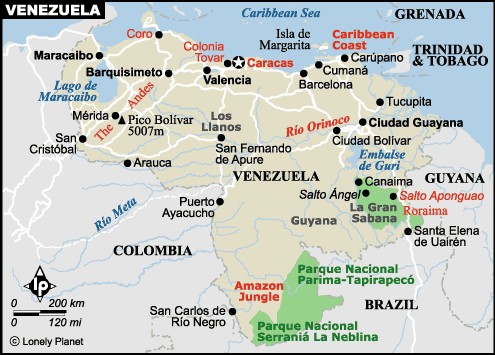
Puerto La Cruz /
Barcelona
located on North coast. This
is where we are with ARGO.
Los Altos
is just to the east.
Angel Falls (Salto Angel) / Canaima
located in Southeast Venezuela.
Merida / The Andes located
in Northwest Venezuela.
Colonia Tovar located west of
Caracas.
Caracas located on north coast.
|
|
Los Altos

Artisan making
dolls completely out of banana
leaves and corn husks |
LOS ALTOS
We took a
relaxing day trip up to Los Altos
which is a little village in the
mountains on the north coast, not
far from Puerto La Cruz.
Mostly artisans here displaying
their crafts and a few local
restaurants. Toured a coffee
plantation, and saw local wild life.
Unfortunately it was overcast and
the clouds were hanging low, so not
a lot of photo ops.
We stopped for lunch at a
place suspended in the mountain
valley clouds where three monkeys -
2 Capuchin monkeys and a 6-month old
red monkey - hang out. Feeding
them apricots got them hyper, so
much so that they were jumping on
lunch patrons, pulled a jar of sauce
off a display table breaking it and
excavated a hole on the thatched
roof over the bar creating a big
mess. The "park" area had
various birds and other animals
living in the open.
|

Pottery
craftsman

With Hector at
his coffee plantation |
|
|
|

From the air, Canaima
Lagoon, Sapo & Sapito Falls (left)
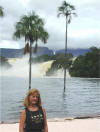
Canaima Lagoon
& Falls

Walking behind
Sapo Falls - at times couldn't see
nor hear

On top of Sapo
Falls; Canaima, Lagoon below

Sapo Falls;
note golden-amber colored water
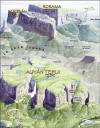
Map of Angel Falls (AuyanTepuy)
center, Canaima Lagoon bottom right,
and river we navigated in between

Latvian friends
(L to R): Girts, Eva, Aldis,
Santa
|
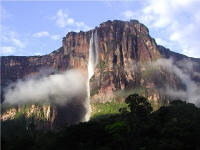
ANGEL
FALLS
(Canaima National Park)
- by Bus, Airplane, Canoe & Foot
Angel Falls at
sunrise - SPECTACULAR !!!
view from the
hammock
Wow what an
adventure! Day 1 we board a
public bus in downtown Puerto La
Cruz for a 5-hour ride to Ciudad
Bolivar, located on the Orinoco
River which is the second largest
river in South America after the
Amazon. There an agent meets
us, the only gringos on the bus, and
takes us to a hotel for the night.
We explore the city and stroll along
the river front.
Day 2, the next
morning, he collects us and puts us
on a 6-seat Cessna plane for a
low-level hour flight in to the
Canaima National Park (1/2 million
acre park), where another agent
finds us and takes us to the base
camp and
posada where we will stay the
2nd night. Canaima, located on
the large and scenic Canaima Lagoon
into which several large waterfalls
empty, is a little village of 800
Kamaracoto Indians. A few posadas,
two stores, airport and local crafts
are all that is here for the
visitor. Our posada
had private rooms with full baths
(cold water only), were very clean
but basic and had the feeling of a
youth hostel. Meals were
served at one very long table so
meeting new people was easy.
A local guide
takes us in a dugout canoe across
the Canaima Lagoon to the base of
Sapo Falls, one of the "golden water
falls". Note in the pictures
the golden-amber color of the water.
This is caused by decomposing plant
matter. Here we hike up to the
falls and walk behind them for an
afternoon adventure. Scary as
the path is narrow, slippery and at
times the thunderously-loud, cold
water is blowing back at us so
strong you can not see where you are
going. Better not slip as it is all
over if you go down the falls with
the tremendous water force. Our
local Indian guide, Jose, kept us
safe.
|
Dugout
canoes here are made from
large, straight cedar trees.
 After
the bark is removed, they hollow
out the inside by strategically
burning the tree and using
tools. Resin is then
applied to help "waterproof".
The whole process takes about a
month, all by hand. These
particular canoes range from 36
- 42 feet in length, with less
than a 3-foot beam. No
keel, so staying in your seat is
important, especially when
making sharp turns to avoid
rocks! After
the bark is removed, they hollow
out the inside by strategically
burning the tree and using
tools. Resin is then
applied to help "waterproof".
The whole process takes about a
month, all by hand. These
particular canoes range from 36
- 42 feet in length, with less
than a 3-foot beam. No
keel, so staying in your seat is
important, especially when
making sharp turns to avoid
rocks! |
Day 3 we again
board a 36 ft. dugout wood canoe
with five other guests and two local
Indians (captain and bowman) and
take a wild ride upstream the Carrao
and Churum Rivers powered with their
48 hp Yamaha outboard for 4 hours.
It has been a particularly rainy
month and the rivers were unusually
high for this time of year - good
thing, otherwise, we may have had to
help carry the canoe over shallow
rocky spots. We had been
advised to bring boat cushions to
sit on so this made it tolerable for
the bottom. At one part the
rapids were too dangerous so we had
to walk for a while while the two
boat boys went up the rapids by
themselves. The skilled Indian
captain seems to bend his canoe
around the rocks and under low
hanging branches at full speed but
he never hit anything. We were
VERY impressed. Although rainy
and cloudy, it is a scenic ride
through jungle and rock canyons.
Tepuys, large geological
outcroppings with flat tops, similar
to buttes in Utah, surround us.
We arrive at the Angel Falls base
camp and take a strenuous hour hike
up the rocky and tree root-laden
mountain with barefooted Indian
Gonzales where the clouds part as we
arrive and offer a spectacular vista
of the falls.
We manage to
get back down without injury and
settle in for cocktails (rum & beer
that we brought) at the camp while
the Indian guides are cooking whole
chickens on an open fire. The camp
had another great view of the falls
and we awed in appreciation of this
natural wonder. Angel Falls (Salto
Angel) on Auyan Tepuy, is the
highest waterfalls in the world.
The vertical free-fall drop is 3,000
feet. The falls were accidentally
discovered by the American pilot
Jimmy Angel in 1937 who flew
charters over this rugged country,
and later crash-landed on the summit
of this tepuy, which is at an
altitude of 1.5 miles.
We understand
that in the early days of travel to
the falls it would take 15 days for
the paddle-powered canoes to make
the trip upriver with affluent
visitors. This was of course before
the Indian guides knew about Yamaha!
Nowadays, trekking adventures up to
the summit take 2 weeks.
The stay at
this rustic base camp was great
provided you don't mind a cold
shower, no electric lights and a
sand floor. Flush toilets were
an unexpected treat, though, with
numerous candles adding ambiance to
the bathrooms and long dining table.
We sleep in mosquito-netted hammocks
under a roof. Unfortunately
there were a couple of really drunk
Polish doctors there on holiday that
snored very loudly all night.
But all this was more than made up
for by the unbelievable view of
Angel Falls across the river,
especially the next morning as the
dawning sun shown perfectly on the
Falls. Our only
complaint is that we would have
liked to stay another night at this
magnificently-located jungle base
camp!
You must
click here for
photo
gallery of our Angel Falls trip
!
Day 4 we left
the Angel Falls base camp for
another thrill boat ride. This
day we had bright blue skies and the
current was with us and we flew down
in just 2 hours for 80 kilometers of
river that took twice as long
yesterday.
We stayed
another night in the posada
at Canaima to clean up and unwind.
During the course of our trip, we
never saw another cruiser. In
fact, out of about 60 people that we
met in Canaima, there were only 3
Americans (young females on extended
travel). We met people, mostly
younger than us, from all over the
world - most which spoke English,
and many doing extended traveling.
We particularly enjoyed making new
friends from Latvia, and others from
England. It's pretty funny
when people ask where we are from:
We say "Texas" (as everybody
has heard of Texas) and their usual
response is "Bush".
Texas/Houston furthermore has the
international reputation for putting
more people to death AND for the
fattest people. We kid you
not. News does get around.
Day 5 we took
another flight back to Ciudad
Bolivar. We had planned on
flying directly over Angel Falls,
but cloudy skies made it not
practical. In Ciudad Bolivar
we got a por puesto (private
car for hire) to drive us back to
PLC and all the comforts of ARGO.
If you're
interested in seeing more great
pictures or more information, check
out:
www.venezuelatuya.com/gransabana/canaimaeng.htm.
Be sure to scroll to the very bottom
of their page for other great links.
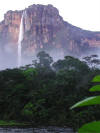 Angel Falls at
sunrise Angel Falls at
sunrise |
|
MERIDA in the ANDES MOUNTAINS
-
check back for details about our
next adventure planned for March.
We are letting Steve's leg recover
for a month. Also, Caracas had
horrendous flooding the middle of
February, which has closed many
roads around that area and has made
traveling to and around Merida more
difficult. We are awaiting
more details before planning our
trip. . .
Our Merida/Andes Mountains trip is
now on
page
13 ...
|
|
|
|
|
[ Back ] [ Home ] [ Up ] [ Next ]
[ Top of page ]
Photo
Gallery of our Angel Falls trip
|
![]()